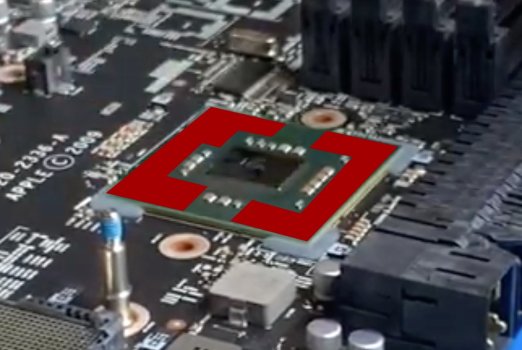OK, an update is due.
I reinstalled the NB radiator getting rid of the original plastic fasteners and created a combination of M3 vinyl screws that I shortened a bit and original springs from the fasteners. From the bottom of the board the screws are fixed with vinyl nuts, with a non-conductive 2mm thick rubber washer between the nut and the actual circuit board.
The length of the screws was chosen by trial and error, I ended up with threads being 18 mm long (
threads only, as the head dimensions may vary). This allows
some vertical movement of the radiator, but the springs are about 50% less visible (50% more compressed) compared to the original setup with plastic rivets.
I chose Noctua NT-H1 that was readily available in my neighborhood hardware store and followed the Noctua application guide (single 3mm drop).
I used the thermal pads to follow the layout
@TzunamiOSX pictured above. Here comes the warning:
use thermal pads only if they are 1 mm thick - or less. I didn't do a detailed check while in store and bought 1.5mm thick pads instead. I warned you. Once I assembled everything back together (disassembly includes removing the board from the metal carrier, removing both CPU radiators, cleaning the old thermal compound from the CPUs, re-pasting the CPUs, the assembly is exactly as exciting) it only turned out the thermal pads I used were too thick and did not allow the desired contact between the NB chip and its radiator. When I started the computer, the X58 IOH diode rocketed to 95°C immediately.
Consumer advice break: use TGPro or any other fan control software that allows sensor-based fan speed policy to avoid a total disaster on your first startup. Yesterday before going to bed I set my BoostA to react to X58 IOH diode value, so fortunately once TGPro loaded it immediately started the fan on full speed. The temperature dropped to 85°C, so it was shutdown time and disassembly again.
Which is why you want to have the proper, thin thermal pads to not do things twice.
So I bought some 1mm pads, applied them and assembled everything together
again. It's now running for 20 minutes (probably mostly idle, but my measurements of ~82°C from past years were with more or less same usage patterns) with following result:
View attachment 2032222
The room temperature is currently 28.75°C (European heatwave, yikes!) so I believe this is a decent result. Also, as you see, the temperature indication difference between heatsink and diode also dropped to very acceptable 9 degrees.
Thanks guys for inspiring me to finally fix it.



